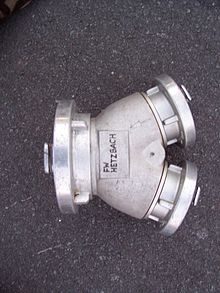Collector's item
The collecting piece (defective part "Y-piece" referred to) is a valve of the water conduction in the fire brigade and the extinguishing agent flows leads of several leads together.
use
It is connected directly to the suction inlet of a pump and reduces it from size A to size B.
Since most fire trucks now have a tank, people have often switched to connecting the water supply line to the tank connection and switching the pump to tank operation. The tank is therefore constantly filled, which makes it much easier to operate the pump and ensures a constant outlet pressure. The claw is coupled to the tank connection and enables water to be supplied from several sources.
The use of a claw is also important when setting up fire-fighting water pumping over long distances and when operating hydrants with portable pumps . The claw prevents a negative pressure in the feeding line by letting in air by opening the non-return valve. Otherwise extinguishing agent could get into the drinking water pipe. It is essential to use the claw when supplying water with pressure (conveying line in a closed row of switches or hydrant operation).
Layout and function
The claw A-2B is standardized in DIN 14355. It consists of a housing with a movable A-lug part and two B-couplings, a non-return valve with guide pin and sealing rings on the couplings. It weighs a maximum of 3.6 kg and can withstand an internal pressure of 25 bar. The non-return valve must seal the unused access watertight at a pressure of up to 16 bar.
The housing in the form of shorts contains the non-return valve controlled by the water pressure, which closes the unused B-access. If another line is connected, the non-return valve levels off in the middle so that both extinguishing agent flows are combined. If a supply line loses pressure, it is automatically blocked, so the pressure in the second supply line is not increased, and a pressureless hose can also be replaced without the entire conveyance having to stop.
With the change in the standard in 2007, the versions of collectibles with three and four B-entrances (A-3B and A-4B) were added. These more versatile water-bearing fittings are preferably used in larger fire engines with high water requirements. They also have a lower susceptibility to failure in the area of the non-return valves.
Hints
A mixed connection, i.e. a line from the hydrant and a line from a feeder pump from open water, is not permitted. The direct connection of drinking water and water supplied from other bodies of water is prohibited. Likewise, only drinking water may enter the extinguishing water tank when the tank is in operation.
literature
- Lutz Rieck: Die Rote Hefte, booklet 06 - fire extinguishing fittings . Kohlhammer, Stuttgart 2000, ISBN 978-3-17-015171-0 , pp. 54-55 .
- Lothar Schott, Manfred Ritter: Fire Brigade Basic Course FwDV 2 . 20th edition. Wenzel-Verlag, Marburg 2018, ISBN 978-3-88293-220-1 .
- Diverse: Hamilton - Handbook for the fire brigade . Boorberg Verlag, 21st edition 2012. ISBN 978-3-415-04560-6
Individual evidence
- ^ Thomas Zawadke: Die Roten Hefte, Issue 217 - Water supply, edition 1 . Kohlhammer, Stuttgart 2009, ISBN 978-3-17-015171-0 , pp. 62 .
- ↑ http://www.beuth.de/de/norm/din-14355/101848807 Beuth Verlag GmbH: DIN 14355 2007-12 collection piece PN 16
